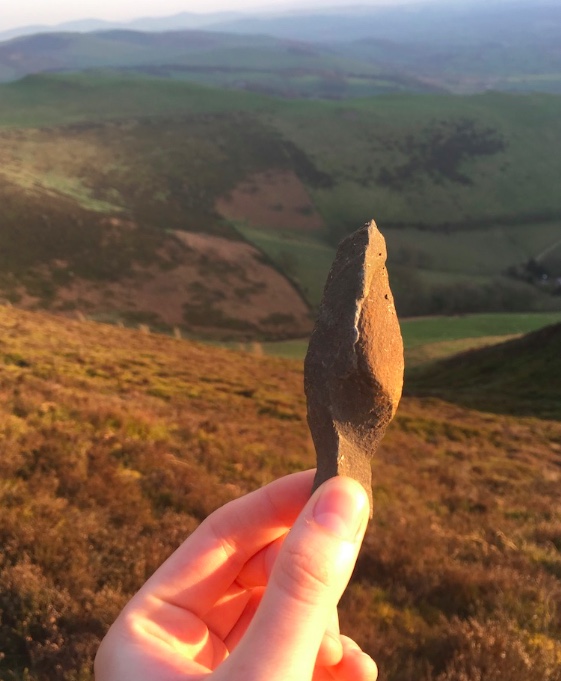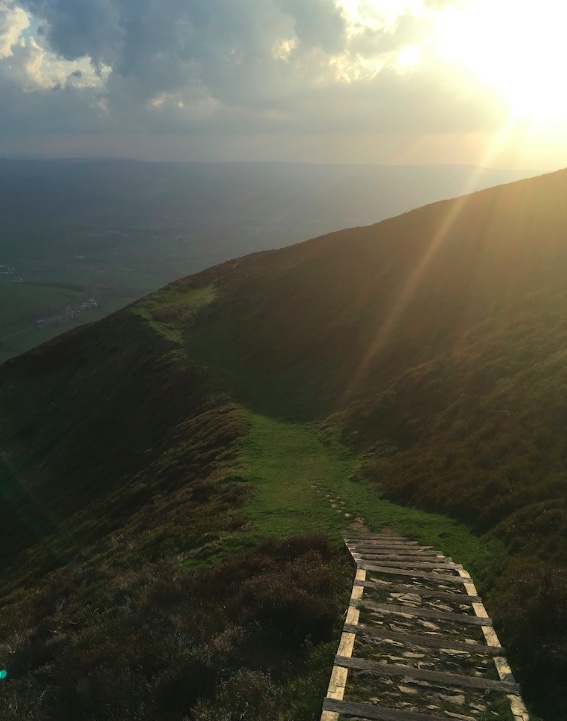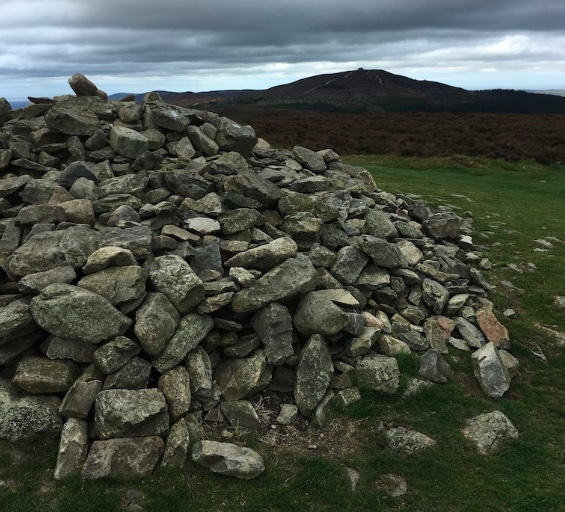Among the ramparts of Moel Fenlli two days ago, I noticed a stone that looked vaguely like an arrowhead just off the path. I picked it up for a closer look. It had razor edges and a perfect tang (this is not the right word, but think of the tang on a sword, and then think of the equivalent on an arrowhead—the bit you’d bind to the shaft). My first thought was to bring it down the hill to show to Gillian, but a lifetime of indoctrination in “take only photos, leave only footprints” kicked in and I put it back where I found it. Besides, as symmetrical as it was, as plausible as it looked, it was much too heavy to be a real arrowhead.
I’d already got through the hillfort, down the other side, and nearly back to the car park when two things occurred to me. First, if the stone was too heavy to be an arrowhead, it was exactly the right size and shape for a spearhead. Second, I was an idiot for not taking photos for Gillian. Which is why I made the trek a second time, found the spearhead, took about fifty photos from different angles in different lighting, and then set it on the edge of the summit stairs where I knew I could find it again if Gillian decided it was worth retrieving.

So I schlepped back down the hill (in the dark by now) and showed the pictures to Gillian in the cottage. She got pretty excited, too, at first glance. But on further examination, she said it didn’t look like it was the right kind of stone, and slate does break in weird shapes naturally. She’d have to see it to be sure.
Which is the long story of how I made the climb to Moel Fenlli a third time yesterday afternoon. As I hiked, I began to fret. I’d left the spearhead in a spot where I could find it again, but so could any passing hiker. I was already composing the sort of poignant short story where that one secret entrance to the fae realm can never be found a second time. I was right. The spearhead wasn’t where I’d left it.
Let me interrupt by saying that I don’t believe in ghosts, but some places just have echoes. The wind carries snatches of an extinct language and if you look over your shoulder, the flap of motion might have been bobbing heather, but might also have been a footfall. It was close to sunset, with that syrupy amber mists-of-time light gilding the ramparts, with the shadows purple in the heather. I found myself wondering what the people of the hillfort would have thought of the tourists who tromp up to the cairn, snap their photos, and leave.

I found myself doing what Gillian had told me she does—talking to the site. Later, I would feel a little silly, but in the moment it seemed appropriate to tell the people of Moel Fenlli that I was just borrowing their stone, and to promise, tattered boots and shredded feet and possible rain and slick steep paths and all, that I would make a fourth climb tomorrow and lay the stone on the cairn at the top of the hill. It was only then that I found the stone again. It had simply fallen off of the edge of the stair and tumbled into the heather.
I brought it back down the hill, beginning to understand what Gillian meant when she said that sometimes it feels like you’re not alone up there even though you’re the only tourist crazy enough to walk that far that late in that wind.
Back at the cottage, I showed the stone to Gillian, who quickly determined that it wasn’t a spearhead, no matter how much it looked like one—but all the same, she’d like to keep it, unless I would. I said that she was welcome to it, but my plan had been to put it back on the cairn. We decided that was the poetically appropriate thing to do. After all, it was still a part of the hillfort.

We got to talking about those echoes. Gillian is a logical, science-based, academically-rigorous archaeologist, but if I tend to think (hope) the echoes are only the sound of the wind in the heather, she’s open to the idea that they might be small bursts of something else, something that can only be called old.
Moel Fenlli is her hillfort. She sits in the outline of a roundhouse just inside the ramparts for hours sometimes. It feels to her like coming home, but it also feels like she isn’t alone. She talks to the site. It can’t understand her language, but it might catch the drift from her tone.
There’s only been one day that she felt unwelcome there. She had just climbed through the gap in the ramparts when she walked through a pocket of what she describes as a soul-deep, murderous hate. It was a feeling she’d never experienced and was pretty sure she wasn’t capable of feeling. She didn’t know whether it was directed at her, or whether she had only intercepted the echo of a feeling projected thousands of years ago at an invader climbing the hill. Either way, she left.
About the hillforts and mounds and cairns, she feels the same way I do, that these are ancient places where people not so different from us lived and loved and died, and that they’re more than places to snap photos for a blog, or more even than places to find possible knapped spearheads to put in cases at the Llangollen History Museum. As places were people lived and loved and died, they’re due a certain respect. She believes in studying the bodies in a burial, dating them, analyzing them, reading their biographies in their bones, and then putting them back. They were laid to rest there thousands of years ago. Let them rest a few thousand more.
There was only one other time, she says, when she felt unwelcome at a site. She was in the Orkneys (or the Hebrides?) and she’d rented a car and driven far, far out to a set of three isolated burial mounds on the far side of a bog. She was the only visitor there. These were burial chambers with entrance passages so narrow that you had to get down on your belly and crawl up to the central chamber. In a way, it was appropriate, approaching the ancestors on your belly. But she emerged from the passage into the chamber and felt something she can only describe as evil. She’s not a panicky person, not even a terribly superstitious one, but she scrabbled back into the passage as fast as she could and got out of there. Three more visitors had pulled up in their car while she was inside. They helped her out of the mouth of the passage. She told them what she had felt. They decided not to go in, either. Some places aren’t meant to be disturbed.
The spearhead, which isn’t really a spearhead but nonetheless a piece of Moel Fenlli, is sitting on the kitchen table awaiting its return to the cairn. Gillian asked me if I was comfortable having it in the house overnight—if not, we could put it outside. It hadn’t occurred to me to be uncomfortable having it in the house, until she said it, and even then, in the last daylight, it was easy to shrug off. Now it’s eleven at night and I’m sitting at the table in the near-dark, writing this, and suddenly, rational or not, I’m a little discomfited. I told Moel Fenlli I would bring the stone back tomorrow. And it’s not even a spearhead. And I doubt I’m the first tourist to carry off a pebble. But things that are easy to shrug off in daylight have more sticking power in the dark, and the house is making funny noises, and what if Moel Fenlli couldn’t understand me?
If I’m never heard from again, you’ll know what happened.
Relieved to say that you will be heard from again for many years to come ! Wonderful post and photo’s again .Thank you